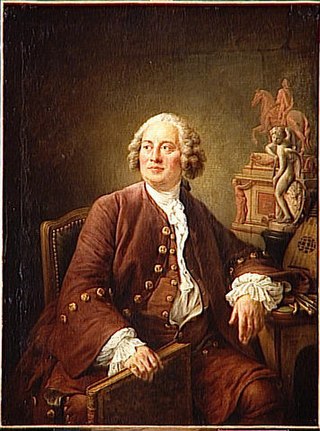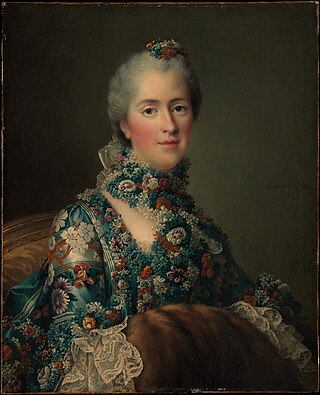| |||||
| Decades: | |||||
|---|---|---|---|---|---|
| See also: | Other events of 1762 History of France • Timeline • Years | ||||
Events from the year 1762 in France
| |||||
| Decades: | |||||
|---|---|---|---|---|---|
| See also: | Other events of 1762 History of France • Timeline • Years | ||||
Events from the year 1762 in France


The Prix de Rome or Grand Prix de Rome was a French scholarship for arts students, initially for painters and sculptors, that was established in 1663 during the reign of Louis XIV of France. Winners were awarded a bursary that allowed them to stay in Rome for three to five years at the expense of the state. The prize was extended to architecture in 1720, music in 1803 and engraving in 1804. The prestigious award was abolished in 1968 by André Malraux, then Minister of Culture, following the May 68 riots that called for cultural change.

Edmé Bouchardon was a French sculptor best known for his neoclassical statues in the gardens of the Palace of Versailles, his medals, his equestrian statue of Louis XV of France for the Place de la Concorde ; and for the Fountain of Four Seasons in Paris. He was also a draftsman and painter, and made celebrated series of engravings of working-class Parisians.

The Louis XV style or Louis Quinze is a style of architecture and decorative arts which appeared during the reign of Louis XV. From 1710 until about 1730, a period known as the Régence, it was largely an extension of the Louis XIV style of his great-grandfather and predecessor, Louis XIV. From about 1730 until about 1750, it became more original, decorative and exuberant, in what was known as the Rocaille style, under the influence of the King's mistress, Madame de Pompadour. It marked the beginning of the European Rococo movement. From 1750 until the King's death in 1774, it became more sober, ordered, and began to show the influences of Neoclassicism.

François-Hubert Drouais was a leading French portrait painter during the latter years of Louis XV's reign. His clientele included the French royal family and nobility, foreign aristocracy, fermiers-généraux, and the wealthier members of Parisian society and their favourites. But it was his increasing popularity at the French court that expanded his clientele and made his portraits a fashionable necessity. Drouais’s work was admired during his lifetime, and his popularity and clientele did not diminish from the occasional adverse judgement published in Salon reviews.
Events from the year 1762 in art.
The Drevet Family were leading portrait engravers of France for over a hundred years. Their fame began with Pierre, and was sustained by his son, Pierre-Imbert, and by his nephew, Claude.
Events from the year 1832 in France.
The École nationale supérieure des beaux-arts de Lyon is a school of art and design in Lyon, located in Les Subsistances, in the 1st arrondissement of Lyon, in the Rhône-Alpes region of France. It is part of the École des Beaux-Arts tradition, that established the Beaux-Arts architecture style.

Jacques Firmin Beauvarlet, a celebrated engraver, was born at Abbeville in 1731. He went to Paris when young, and was instructed in the art by Charles Dupuis and Laurent Cars. His first manner was bold and free, and his plates in that style are preferred by some to the more finished and highly-wrought prints that he afterwards produced, although it must be confessed that the latter are executed with great neatness and delicacy. Beauvarlet married, in 1761, Catherine Jeanne Françoise Deschamps, a young lady who possessed some skill in engraving, but who died in 1769 at the age of thirty-one. He married again in 1770, but became for a second time a widower in 1779. Eight years later, in 1787, he married Marie Catherine Riollet, who, like his first wife, was an engraver. She was born in Paris in 1755, and is said to have died in 1788. Beauvarlet himself died in Paris in 1797.
Jean-François Cars, was a French engraver, printer, publisher and printseller from Lyon.

Préville was a French comic actor.
Louis-Philippe Mouchy was a French sculptor.

Jacques Guay (1711–93) was a French gemstone engraver, a protégé of Madame de Pompadour (1721–1764), mistress of King Louis XV of France (1710–74). He was the most eminent gemstone engraver of his time, the official engraver of the king, and produced many cameo and intaglio engravings in semi-precious stones such as onyx, jasper and carnelian. Subjects included classical figures, events in the reign of the king and portraits of members of the court.
Events from the year 1715 in France
Events from the year 1750 in France
Events from the year 1717 in France
Events from the year 1755 in France

Gilles Demarteau or Gilles Demarteau the Elder was an etcher, engraver and publisher who was active in Paris for his entire career. He is one of the persons to whom has been attributed the invention of the crayon manner of engraving. He is recognized as playing an important role in the development of this engraving technique. He was one of the key reproductive engravers and publishers of the work of François Boucher.
Jean-Baptiste Bouchardon was a 17th/18th-century French sculptor and architect.